Located in New South Wales, Australia, Maitland is 35 km (22 miles) northwest of
Newcastle on the banks of the Hunter River.
Maitland, a town with abundant character and many historic buildings, is a gem.
Wonnarua people
The Wonnarua people (the people of the hills and plains) have lived around the Maitland region for
thousands of years.
According to Dreamtime stories, a spirit named Baiame, the great Spiritual authority, and supernatural being, created the Hunter Valley. This story is depicted in rock art at Baiame Cave,
located at Milbrodale, painted more than 3000 years old.
 |
| Aboriginal rock art at the Biamie's Cave, at Milbrodale, NSW |
Wonnarua hunters closely observed animal behaviour and the environment. Hunting kangaroos (womboin) involved a strategy of burning grasslands and returning
to the location some weeks later when the animals would feed on the
fresh grass. The hunters would encircle the animal with spears ready. kangaroos would also be caught in nets (kurrila), and hunters would be armed with clubs.
Nets
were also used to catch emus (murrin) and fish (makroo). Wonnarua boys owned small spears (durrane), boomerangs (barragan) and shields (korreil). Girls had dillybags (buakul), coolamons (koka) and string bags (buakuls). Males and females generally had very defined and
separate roles, as well as separate sites for mens' and womens' business.
The
social structure of the Wonnarua peoples consisted of "hearth groups" of about 10 people: a man, his wife or wives and their dependent children. Several of these "hearth groups" would often form bands of about 40-60 people (Lourandos 1977).
 |
| Aboriginal people lived in "hearth groups" of about 10 people and "hearth groups" would often form bands, Table Talk |
Marriage
alliances were generally arranged by infant betrothal of a female to a much older male. At the age of puberty, the female was married, but a man would likely be in his late twenties or even later.
According to James Miller, Wonnarua would take a wife by force from neighbouring tribes, who would, in turn, make raids on their women. In particular, the Kamilaroi, who occupied the headwaters of the Hunter River.
Infanticide was practised, according to James Miller (1985),
due to the difficulty of a woman carrying more than one young child as she moved about.
Initiated males
were treated with reverence after death, covered with bark and buried with the head touching the knees. Cultural and grief practices involved wailing and self-inflicted head-cutting and burning of arms.
In colder months the Wonnarua wore possum-skin cloaks. They would make temporary shelters of bark, branches, leaves and grass (a mia-mia).
 |
| An Aboriginal mia-mia, Sydney Morning Herald (NSW : 1842 - 1954), Thursday 8 March 1934 |
Initiation occurred along the creeks and tributaries, with young men undergoing such rites as circumcision, scarring and tooth extractions.
Wonnarua
archaeological sites in the area include fish traps, artefact scatters, grinding grooves, and scarred trees. The Wonnarua called the Maitland area Bo-un after a species of bird.
"The land of the Wonnarua not only held human and animal life. It was the home of the spirits — spirits who were born in the Dreaming". James Miller.
 |
| King Tom of Dunmore, Maitland. September 1861 / photographer unknown. King Tom of Dunmore, Maitland, is captured on film by an unknown studio photographer. He is sitting cross-legged, wearing a breast plate and holding a boomerang. King Tom involves himself in local community life and is well known and respected for donating a pair of wild ducks valued at five shillings to a Patriotic Fund for widows and orphans of men killed in the Crimean War and taking part in the funeral procession of local farmer, David Dickinson. King Tom is an Aboriginal warrior who is often seen about the Maitland district wearing his brass breast plate. (Maitland Mercury, 25 August 1877) |
Some of this information comes from "Koori, a Will to Win: The Heroic Resistance, Survival & Triumph of Black Australia", by James Miller (1985).
1790s
Five escaped convicts were shipwrecked at Port Stephens in 1790. They spent five years with the Worimi Aboriginal people before they were rescued in 1795. However, the men had Worimi wives, and children.
In 1791 shipwrecked, escaped convicts and their families arrived at Port Stephens. Some escaped convicts in 1797, landed their boat at Port Stephens. Captain Shortland was sent to find the convicts in August of that year and found the Hunter River. Shortland reported seeing coal during his journey. This place was called Coal River (Newcastle).
1800s
Lieutenant-Colonel Paterson of the NSW Corps
explored the Hunter Region in 1801. He named the place that would become Maitland Schanck's Forest Plains.
 |
| Colonel William Paterson, was a Scottish soldier, explorer, Lieutenant Governor and botanist (17 August 1755 – 21 June 1810) |
Timber cutters arrived in the area and
called the land between East and West Maitland, The Camp (1812).
Under Captain John Wallis, Commandant at Newcastle, a few small farms were established, and the settlement became known as Wallis Plains.
 |
| Major James Wallis (11 October 1785 – 12 July 1858) was an officer in the 46th Regiment of Foot of the British Army |
In 1818 Governor Macquarie visited the locality and decided that it would open for settlement. Well-conducted emancipated convicts were granted
small plots of land. In that year, John Eckford, John Smith and William O'Donnell arrived and took up land. Others soon followed.
William O'Donnell, one of Maitland's first settlers, came to Australia from India as a retired non-commissioned officer. His grant was of 33 acres, which included Abbot and Sparke Streets.
O'Donnell built his first home in West Maitland - a small ironbark slab structure with a bark roof at the east end of High-street.
The convicts were calling the area Morgan's Plains by 1819 after
twice transported convict Molly Morgan, the daughter of a rat catcher from Shropshire, England.
By 1819, Molly Morgan, along with other convicts, was sent to Wallis Plains (Maitland). She began farming, established a wine shanty, and was allowed by Governor Sir Thomas Brisbane to lease 159 acres (later granted to her). Morgan bought a further 203 acres and established the Angel Inn at a site that would become the centre of the town of Maitland.
The first flood recorded at Maitland was in 1819.
Cutting a Path
John Howe
cut a path from Windsor to Singleton, now known as the (Lower) Hunter Valley, in 1820 (The Putty Road). Howe was accompanied and assisted by Aboriginal guides: Myles, Mullaboy, Murphy, Whirle and Bandagran.
The British Government’s Commission
of Inquiry in New South Wales, was conducted by John Thomas Bigge from 1819 to 1821.
There were eleven farms at Wallis Plains by 1820. These small farmers mostly lived in wattle and daub cottages.
In 1821, Port Macquarie replaced Newcastle as a penal settlement for convicts, and the Hunter River was
opened for settlement in 1821.
In the late 1820s, the Surveyor-General, Thomas Mitchell, suggested the creation of three main roads leading to the main provincial centres: a Great South Road to Goulburn, a Great
Western Road to Bathurst, and a Great North Road to Maitland.
Itinerant clergyman of the Church of England were in the Maitland district in 1821, and by the 1830s, there were four parishes of the church.
 |
| Evening News (Sydney, NSW : 1869 - 1931), Saturday 24 September 1910 |
By 1823 vineyards had been planted on the northern banks of the Hunter River, on what is now the Dalwood /Gresford area between Maitland and Singleton.
Boucher and Powditch's general store opened in West Maitland in 1825. They were Maitland's first merchants
.  |
| No Maitland Road from Newcastle, NSW, Voice of the North (NSW : 1918 - 1933), |
As the Northern Road passed through very difficult country, travel by sea was still largely favoured. (many original convict-built features still exist on the
Great Northern Road)
In February 1826, a mounted police unit was based at Wallis Plains (now called Maitland). The troopers were used to capture escaped convicts and suppress Aboriginal resistance.
 |
| Australian (Sydney, NSW : 1824 - 1848), Saturday 24 March 1827 |
 |
| Australian Town and Country Journal (Sydney, NSW : 1870 - 1919), Saturday 14 December 1872 |
The Angel Inn was licensed in High Street in 1827.
By 1828, 43 per cent of European residing in the Hunter Valley were free settlers.
The first circuit-court was held at Maitland in 1829.
First Post Office
A Post Office was opened at Maitland on 1 September 1829.
By 1829, the convict-built road from Richmond to Maitland via Ellalong, was completed. Terrible stories were told of the brutal treatment of the convicts. Later a new road was constructed from Newcastle to replace the old bridle track.
Also in 1829, Governor Darling decided a town should be
established and surveyed. The town was then named Maitland (but now known as East Maitland). In 1835, the other settlement of the town objected to being ruled by East Maitland, and on November 9, 1835, the two towns of East and West Maitland were proclaimed.
 |
| Sydney Mail (NSW : 1912 - 1938) |
The Maitland Inn and the Albion Inn
were established at West Maitland in 1830.
Nearby Morpeth, which was one of the most important river ports in NSW, became Maitland’s main thoroughfare for trade and travel, with a regular river steamer service.
Maitland was named after "Sir George Maitland, ... Under Secretary for the Colonies" and established as a town in 1829 under Lieutenant-General Ralph Darling's town planning regulations. The area was surveyed by Thomas Mitchell, who envisaged the town as, "an ornamental feature of the landscape".
Benjamin Cox held the licence for the Rose Inn in 1832 (46 Newcastle Road, East Maitland).
The Scotts Kirk at Maitland began in 1832.
The Hunter River enabled transport for the timber industry, as steamships could dock at nearby Morpeth, and goods could be transported to Maitland by bullock teams and wagons.
Aboriginal men were often employed in the Hunter Valley throughout the 1830s-40s, to take Europeans on hunting or fishing expeditions, and as message carriers assisting botanical and natural history collectors.
Proclaimed a Town
The Catholic St Jospehs at East Maitland
was built in 1834.
Phillip Joseph Cohen was appointed Postmaster in 1835.
 |
| Sydney Gazette and New South Wales Advertiser (NSW : 1803 - 1842), Saturday 29 March 1834 |
The first shop was opened in Maitland byHenry Rourke, a saddler, in 1836.
 |
| Maitland's first shop, 1838, NSW, Newcastle Sun (NSW : 1918 - 1954) |
A branch of the Commercial Banking Company of Sydney opened at West Maitland in 1836.
 |
| Sydney Herald (NSW : 1831 - 1842), Thursday 22 December 1836 |
 |
| Sydney Monitor (NSW : 1828 - 1838), Wednesday 29 March 1837 |
From 1839 Samuel Owen and Company
operated a general store in West Maitland.
 |
| High Street, West Maitland as it used to be, NSW. Sydney Mail and New South Wales Advertiser |
Hunter River Steam Navigation Company formed in 1839.
Aberglasslyn House, northwest of Maitland, was built in 1840 out of sandstone by George Hobler and designed by John Verge. The area of Aberglasslyn was originally a grant of 1,100 acres in 1822 to Henry Dixon Owen.
 |
| Aberglasslyn House, north-west of Maitland was built in 1840 , NSW, Newcastle Morning Herald and Miners' Advocate (NSW : 1876 - 1954) |
Caroline Chisholm begins settlement program for female immigrants
Caroline Chisholm's cottage in Mill Street, East Maitland, was built in 1842
as a home for female immigrants.
 |
| Caroline Chisholm |
 |
| Caroline Chisholm House, East Maitland 3 Mill Street, built in 1842, as a home for female immigrants |
The construction of the Maitland Gaol began in 1844.
A visitor to the Goal in 1914 described it as place of,
"temporary confinement, till the prisoners are examined and transferred to Newcastle: it consists of a few cells, enclosed within a high, wooden fence, and is said to sometimes be so crowded that prisoners have to be brought into the yard to avoid suffocation."
 |
| Maitland Gaol construction was started in 1844 and prisoners first entered the gaol in 1848 |
 |
| MAITLAND. ABORIGINAL FIGHT. On Tuesday last a great number of the aborigines, amounting to more than a hundred men, women, and children, passed through the town to Canybell's (sic- should be Campbell's) Hill for the purpose of holding a corrobery. It was evident from their manner that they were two hostile parties, and that one was somewhat suspicious of the other. They encamped at different places on the Hill, near the old Black Swan, and held their corrobery(sic) during the night. One party consisted of the Maitland tribe, and a few of the Sugar Loaf, Wollombi, and Glendon tribes ; she other of the Port Stephen and Paterson tribes. Geelong Advertiser (Vic. : 1840 - 1845), Monday 26 June 1843 |
Some Early Businesses
By the 1840, a variety of crops were grown around Maitland. Wheat and leather being of great economic importance.
The original bullock track is still evident in the curve of High Street today.
The first shop in the town of Maitland is said to have belonged to Henry Rourke, a saddler, which opened in 1836. Only a part of the original large building remains today at 417 High Street. The shop was later used by the RSL and then Best & Less.
 |
In 1836 Henry Rourke established the first shop in Maitland, NSW, Newcastle Sun (NSW : 1918 - 1954), Monday 8 September 1947 |
The local newspaper, The Hunter River Gazette, 1841-42, was succeeded by the Maitland Mercury in January 1843.
The Maitland Mercury newspaper was first published in 1843, making it Australia's third oldest regional newspaper. At this time, wheat and sheep farms
were being established to the west of Maitland. By 1868, there were four flour mills in the Maitland vicinity, and by the 1880s, coal mining towns were cropping up around the Maitland area.
Near the present location of Maitland Library, 480 High Street, J. Milne’s Millstream Brewery (previously Vindin’s Flour Mill) once existed.
Twenty Hotels
Drought and Depression in 1843.
After floods at Maitland, the Benevolent Asylum was moved on 5 October 1843, to Hannan House at West Maitland.
The Plough Inn, built for John Callaghan in 1844, is now found in the grounds of All Saints' College, facing High Street.
In October 1844, Henry Carmichael, who had been the first vice-president of the Sydney Mechanics'
School of Arts, opened a boarding school for training students in agriculture near Seaham.
There were many Jewish entrepreneurs living at Maitland, and a Jewish Cemetery was established in 1846, on Louth Park Road.
Phillip Joseph Cohen opened a soap factory in Maitland in 1833, and in 1835, he was the deputy postmaster of the town. Cohen was listed as the publican of the Rose Inn in 1842 but he was soon declared insolvent. The warehouse David Cohen & Co. is located on High Street.
 |
| Maitland Mercury and Hunter River General Advertiser (NSW : 1843 - 1893), Saturday 18 October 1845 |
In 1848, 12 horse buses
had licences to operate in High Street.
Maitland Hospital was opened in 1849.
1850s
In 1852 a meeting was held in Maitland to protest against the arrival of Chinese immigrants.
 |
| Believed to be the High Street in West Maitland, NSW, with the street flooded and buildings with the signs H. Thomas, Central Printing Office, and The Maitland Hotel; H2010.134/85 shows a flooded street (possibly Devinshire Street) with buildings on either side, including the Municipal Council Chambers, SLVIC |
 |
| Believed to be the High Street in West Maitland, NSW, with the street flooded and buildings with the signs H. Thomas, Central Printing Office, and The Maitland Hotel; H2010.134/85 shows a flooded street (possibly Devinshire Street) with buildings on either side, including the Municipal Council Chambers, SLVIC |
The railway from Newcastle reached West Maitland in 1858.
1860s
The first gas works was established by J.W. Tuck in 1860.
A Telegraph Office was opened at East Maitland in 1862.
Willam McLaughlin established a bakery in Maitland in 1864. However, he drowned in the 1870 flood while delivering bread. McLaughlin's wife, Susannah, took over the business. The building can still be seen at 20 Victoria Street, Maitland. The building
was built in the 1860s and formed part of an allotment given to Molly Morgan in 1835.
 |
| Adults, children and a dog in or around a rowing boat on a flooded street corner, West Maitland, June 1864. NLAUST |
In 1866, West Maitland, which had become the commercial and administrative centre, had a population of 5694 people, while East Maitland had a population of about 2000.
 |
| Empire (Sydney, NSW : 1850 - 1875), Tuesday 12 November 1867 |
 |
| ABORIGINAL CORROBOREE AT MAITLAND, NSW, .Kiama Independent, and Shoalhaven Advertiser (NSW : 1863 - 1947), Thursday 8 July 1869 |
1870s
Brough House and Entcliffe are designed and built by architect William White, on Church Street.
Coal mining commenced around West Maitland in the 1870s.
 |
Biddy of Maitland, NSW [studio portrait of an Aboriginal woman, ca. 1875]
SLNSW |
 |
| Maitland Railway Station: Dated: by 31/12/1877, NSW State Archives |
The first gas-lit street lamps were installed in West Maitland in 1878.
1880s
The Maitland Post Office building was completed in 1881.
 |
| Maitland Hotel, West Maitland, NSW, 1880 |
In 1884 Maitland Girls’ High and Maitland Boys High opened.
 |
| Maitland Girls' High School, NSW, 1884-1893 Maitland Daily Mercury |
Rail bridge across Hawkesbury River opened in 1889.
1890s
Maitland Technical College began in 1890. However, a college building was not constructed until 1909.
The Department of Lands Building opened in 1891.
A telephone exchange opened in Maitland in 1891.
Aboriginal people, who had lived by a combination of hunting, gathering and fishing, experienced the loss of their lands and natural resources. Many died from diseases to which they had no immunity. Many were displaced from their lands. The Aborigines Protection Board established missions, including, St Clair Mission in the Hunter region in 1893.
Maitland's Walka Water Works
Maitland's Walka Water Works is located just outside the centre of Maitland.
This historic pumping station was built between 1879 and 1885 by the state government to supply Cessnock, Newcastle, Morpeth, Maitland
and surrounding districts with clean water. Before this, residents sourced their water from boreholes, creeks and storage tanks.
 |
| Opening of East to West Tramway in Maitland, N.S.W. - 8 February 1909, Public Domain |
 |
| Massey Harris farm machinery, Maitland. n.d. Public Domain |
1900s
In 1900 a two-storey brick building replaced most of the old Angel Inn.
 |
| Angel Inn, Maitland, N.S.W. 1901. In 1900 a two-storey brick building replaced most of the old inn. Picture Maitland |
 |
| Benevolent Home, Maitland, NSW, Australasian (Melbourne, Vic. : 1864 - 1946), Saturday 18 August 1900 |
 |
| Maitland Cricket Team, Sydney Mail and New South Wales Advertiser (NSW : 1871 - 1912), Saturday 3 November 1900 |
 |
| POULTON'S BOOK ARCADE, Maitland, NSW, Australian Town and Country Journal (Sydney, NSW : 1870 - 1919), Wednesday 19 November 1902 |
 |
| MR, W. SKINNER'S WEST END, , VEHICLES AND , FURNITURE BAZAAR, Maitland, NSW, Australian Town and Country Journal (Sydney, NSW : 1870 - 1919), Wednesday 19 November 1902 |
 |
| Mr A Anthony's business premises, Australian Town and Country Journal (Sydney, NSW : 1870 - 1919), Wednesday 19 November 1902 |
 |
| Poulton's Book Arcade and Newsagent, Maitland, NSW, Australian Town and Country Journal (Sydney, NSW : 1870 - 1919), Wednesday 19 November 1902 |
 |
| 1. MESSRS. E. P. CAPPER AND SONS' ESTABLISHMENT, 2. BUSINESS PREMISES OF MESSRS. A. E. WHITTET AND COMPANY. Maitland, NSW, Australian Town and Country Journal (Sydney, NSW : 1870 - 1919), Wednesday 19 November 1902 |
 |
| High Class Tailor, F E English, Maitland, NSW, Australian Town and Country Journal (Sydney, NSW : 1870 - 1919), Wednesday 19 November 1902 |
 |
| In the Maitland district, mowing lucerne, NSW, Sydney Mail and New South Wales Advertiser (NSW : 1871 - 1912), Wednesday 20 May 1903 |
 |
FRY BROS., FURNITURE WAREHOUSEMEN. 'The Biggest Furniture Shop in the North.', NSW. Richard and Henry Fry, two Maitland boys, started in business under the style of Fry
Bros. Sydney Mail and New South Wales Advertiser (NSW : 1871 - 1912), Wednesday 2 May 1906 |
 |
| James Kerr & Sons, Maitland, N.S.W. Sydney Mail and New South Wales Advertiser (NSW : 1871 - 1912), Wednesday 2 May 1906 |
 |
| High Street, Maitland, NSW, Sydney Mail and New South Wales Advertiser (NSW : 1871 - 1912), Wednesday 2 May 1906 |
 |
| The Maitland Federal Band, NSW, Australian Town and Country Journal (Sydney, NSW : 1870 - 1919), Wednesday 5 December 1906 |
The Australian Boxer: Les Darcy
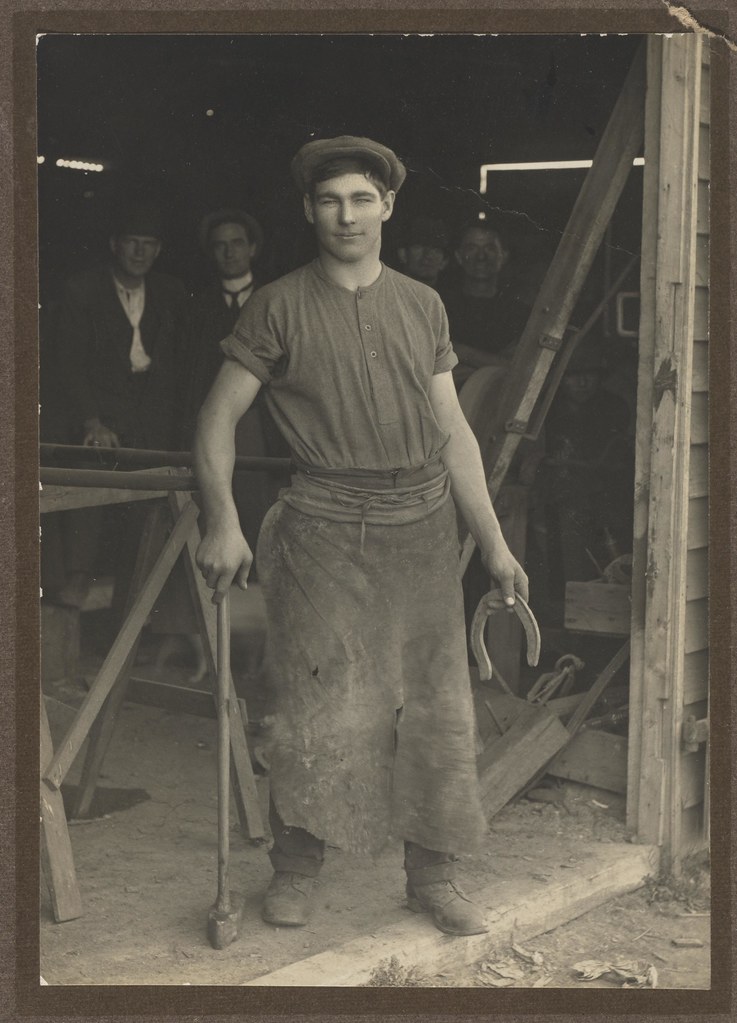 |
| "Les Darcy at the blacksmith shop door", East Maitland, ca. 1910 / Victor Studios. State Library NSW. P.D. James Leslie "Les" Darcy, the Australian boxer who was a middleweight but held the Australian Heavyweight Championship title at the same time, was born near Maitland in 1895. Les left Oakhampton Public School in 1907 and worked as a carter before being apprenticed at 15 to a blacksmith at East Maitland. |
A government tram service linked East Maitland with West Maitland in 1909, replacing horse-drawn buses between 1909 and 1926..
 |
| View in High Street, West Maitland, NSW, Sydney Mail (NSW : 1912 - 1938), Wednesday 21 August 1912 |
 |
| West Maitland railway station, NSW, Sydney Mail (NSW : 1912 - 1938), Wednesday 21 August 1912 |
 |
'Union Markets' at the saleyards near the railway station West Maitland, NSW, Sydney Mail (NSW : 1912 - 1938), Wednesday 21 August 1912 |
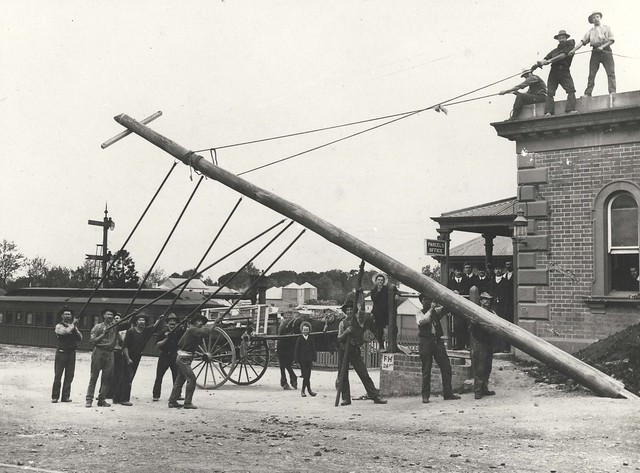 |
| Maitland Railway Station, circa 1909. NSW State Archives. No known copyright restrictions |
 |
Opening oi the Maitland Tramway. EAST and WEST MAITLAND are now connected by a
tramway., NSW, Sydney Mail and New South Wales Advertiser (NSW : 1871 - 1912), Wednesday 17 February 1909 |
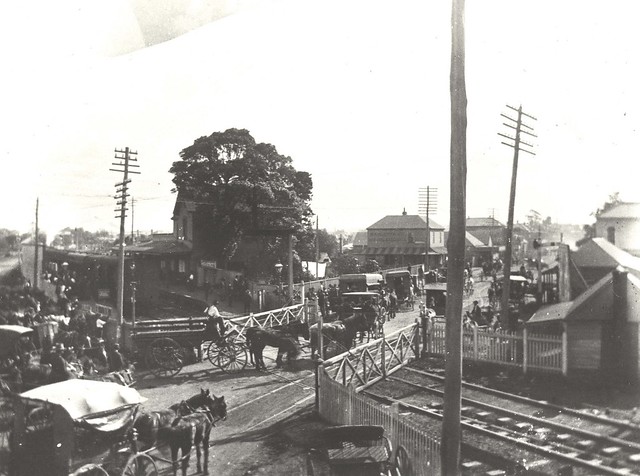 |
| West Maitland Railway Station, now known as Maitland Railway Station, December 1911. NSW State Archives. No known copyright restrictions. |
 |
| Maitland Show, NSW, Sydney Mail and New South Wales Advertiser (NSW : 1871 - 1912), Wednesday 10 May 1911 |
 |
| Maitland, NSW, 1913 flood, Picture Maitland |
WWI
The 34th Battalion was formed in January 1916 at a camp established at the Maitland showground.
 |
| Lieut.-Colonel Scobie (and family), of West Maitland,N.S.W, who has died of wounds, was the son of the late Mr. Scobie. member for Maitland in the New South Wales Legislative Assembly. He rose from the ranks, went right through the Boer campaign, and returned as captain. He was wounded in the nose in the first attack at the Dardanelles, and, after recuperating in Egypt for several weeks, returned to the front as lieut.-colonel. He was about 39 years of age. Australasian (Melbourne, Vic. : 1864 - 1946), Saturday 28 August 1915 |
 |
| In the centre of the group is Nurse Soilling, who was mentioned in despatches by General Sir Douglas Haig, is the eldest daughter of Mr. ahd Mrs. J. S. Soiling, of West Maitland, NSW. Daily Telegraph (Sydney, NSW : 1883 - 1930), Wednesday 21 June 1916 |
 |
THE PEIRCE BROTHERS, Of East Maitland. THESE are the three, soluier sons of Rev.
Peirce, of East Maitland, N.S.W., a district that has sent a splendid quota of mento the front, as the recent casualty lists have so plainly shown. Harold and Fred Peirce are still on active service, but Sidney died of wounds in France some months ago, the deed that brought about his death also winning for him the Military Cross. Both he and Fred were science students at Sydney University. Sydney Mail (NSW : 1912 - 1938), Wednesday 13 September 1916 |
 |
| Maitland Ambulance, NSW, 1920s |
 |
| The weekly market at West Maitland, NSW, Sydney Mail (NSW : 1912 - 1938), Wednesday 21 January 1920 |
Electricity was connected at West Maitland in 1922, and extended to East Maitland in 1923.
The first known motorcycle speedway happened at West Maitland Showground December 15, 1923.
 |
| Sydney Mail (NSW : 1912 - 1938), Wednesday 16 November 1927 |
 |
| A HIDDEN HOARD, — Somewhere on this farm at Largs, in the Maitland district, the late Mr. E. Golby, the former owner, is supposed to have hidden over £10,000 in gold. Its whereabouts is a mystery. Daily Telegraph (Sydney, NSW : 1883 - 1930), Tuesday 22 May 1928 |
1930s
 |
| Sunday Times (Sydney, NSW : 1895 - 1930), Sunday 16 March 1930 |
 |
| Labor Daily (Sydney, NSW : 1924 - 1938), Thursday 19 November 1931 |
 |
| Maitland Rugby union Ball, NSW, Newcastle Sun (NSW : 1918 - 1954), Wednesday 2 August 1933 |
 |
| PREVENTION AGAINST FLOOD NEAR EAST MAITLAND. NSW. Sydney Morning Herald (NSW : 1842 - 1954), Tuesday 21 March 1933 |
 |
| MAITLAND UNITED v. Waratah-May field, NSW, Daily Telegraph (Sydney, NSW : 1931 - 1954), Monday 10 September 1934, |
 |
| High Street, Maitland, NSW, Sydney Mail (NSW : 1912 - 1938), Wednesday 6 November 1935 |
 |
| Part of the Maitland, NSW sewerage plant, NSW, Newcastle Morning Herald and Miners' Advocate (NSW : 1876 - 1954), Saturday 27 November 1937 |
 |
| The Walka waterworks, near Maitland, NSW, Newcastle Morning Herald and Miners' Advocate (NSW : 1876 - 1954), Monday 20 September 1937 |
 |
| West Maitland Methodist Church, NSW, Methodist (Sydney, NSW : 1892 - 1954), Saturday 5 June 1937 |
 |
| Newcastle Morning Herald and Miners' Advocate (NSW : 1876 - 1954), Saturday 18 June 1938 |
 |
| Members of the Maitland Women's Hospital Auxiliary who make sewing for the hospital part of their work. Newcastle Morn ing Herald and Miners' Advocate (NSW : 1876 - 1954), Friday 24 June 1938 |
 |
| A group of spectators at the polo, Maitland, NSW, Newcastle Sun (NSW : 1918 - 1954), Thursday 29 June 1939 |
 |
| Sulkies are still fairly commnton in Maitland, but not many have pneumatic tyres. Above: Mrs. Hardes, of Duckenfleld, travelling to Maitland de luxe on a shopping expedition. Newcastle Morning Herald and Miners' Advocate (NSW : 1876 - 1954), Tuesday 15 August 1939 |
The first part of the sewerage scheme for Maitland was completed in 1939.
1940s and WWII
Largs Military camp near West Maitland, was completed 19 June 1940, located between the village of Largs and Dunmore House.
 |
| Fully equipped mines rescue car at South Maitland Rescue Station, Abermain, Dated: No date, NSW State Archives |
 |
| Corporal Neville ERNST (12305) of the Royal Australian Air Force, Maitland, NSW, Sun (Sydney, NSW : 1910 - 1954), Thursday 4 March 1943 |
 |
| Maitland Nurse Released. Nurse Mavis Green, who has been released from a Japanese prison camp in Japan. When the release of Nurse Green and her companions was announced on Tuesday night there was many callers at her mother's home in Brunswick-street, East Maitland, NSW. Newcastle Morning Herald and Miners' Advocate (NSW : 1876 - 1954), Saturday 8 September 1945 |
 |
In Maitland, NSW, as a child of three or four, the artist, Miss Joy Ewart, drew everywhere
"on walls, on every blank sheet of paper, and often in earthwith a stick. Joy was born with Marfan's syndrome, a congenital disorder of the connective tissues. "Newcastle Morning Herald and Miners' Advocate (NSW : 1876 - 1954), Thursday 4 September 1947 |
Severe floods in Maitland in June 1949, caused BHP to close their blast furnaces for the first time in history, and almost 10,000 men lost their jobs.
 |
| Six migrant girls from Greta Camp have been accepted as trainee nurses at Maitland Hospital, NSW, to help ease the nursing shortage., Newcastle Morning Herald and Miners' Advocate (NSW : 1876 - 1954), Thursday 24 November 1949 |
1950s
 |
| Mrs. Milton Edmonds from Singleton, cooking judge, with some of the stewards, at the Maitland Show, NSW, Newcastle Sun (NSW : 1918 - 1954), Thursday 2 March 1950 |
 |
| Maitland, High Street, NSW, Newcastle Sun (NSW : 1918 - 1954), Monday 26 June 1950 |
 |
| Maitland floods, NSW, Daily Telegraph (Sydney, NSW : 1931 - 1954), Friday 15 August 1952 |
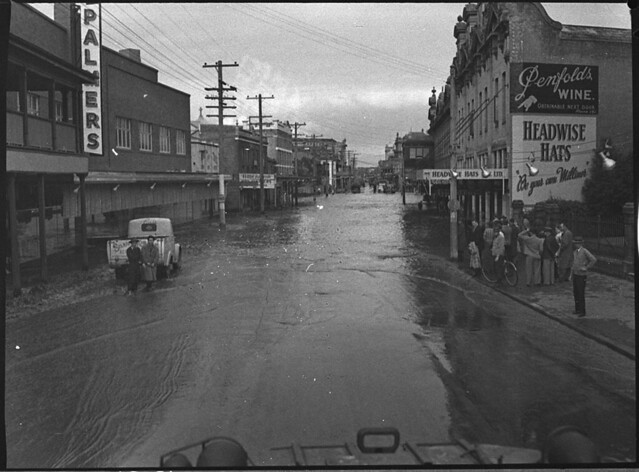 |
| High Street looking towards Town Hall, Maitland, August 1952, by Sam Hood. State Library of NSW. No known copyright restrictions |
 |
| Scone Advocate (NSW : 1887 - 1954), Friday 15 May 1953, |
 |
| Newcastle Sun (NSW : 1918 - 1954), Tuesday 11 May 1954 |
The flood of 1955 resulted in 11 deaths.
Around Maitland
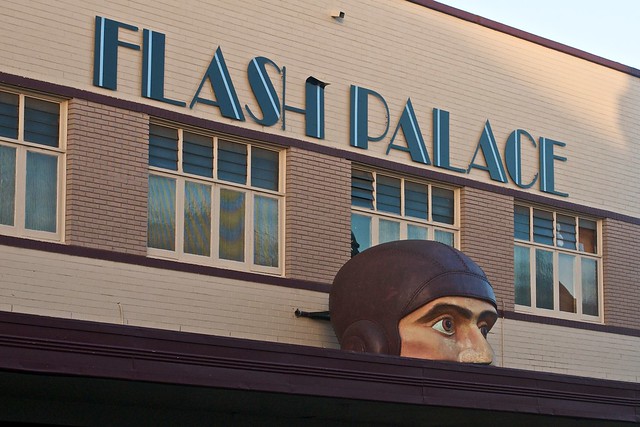 |
| Circa, 1950, High St, Maitland, NSW. Nomad Tales (being turned into apartments) |
.jpg) |
| Grand Junction Hotel on Church St in Maitland, NSW, built in 1916 by Tooth and Company |
 |
| Former Currency Lass Hotel Hotel established in 1856, Maitland, NSW |
 |
| Wylies Building, circa 1886. Melbourne St, East Maitland, NSW. Nomad tales |
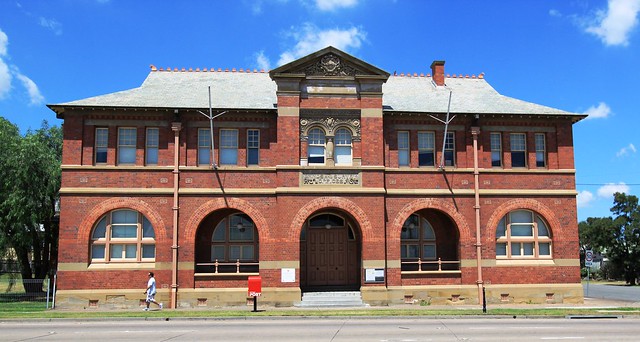 |
| Lands and Survey Offices, East Maitland, NSW. circa 1897. OZinOH |
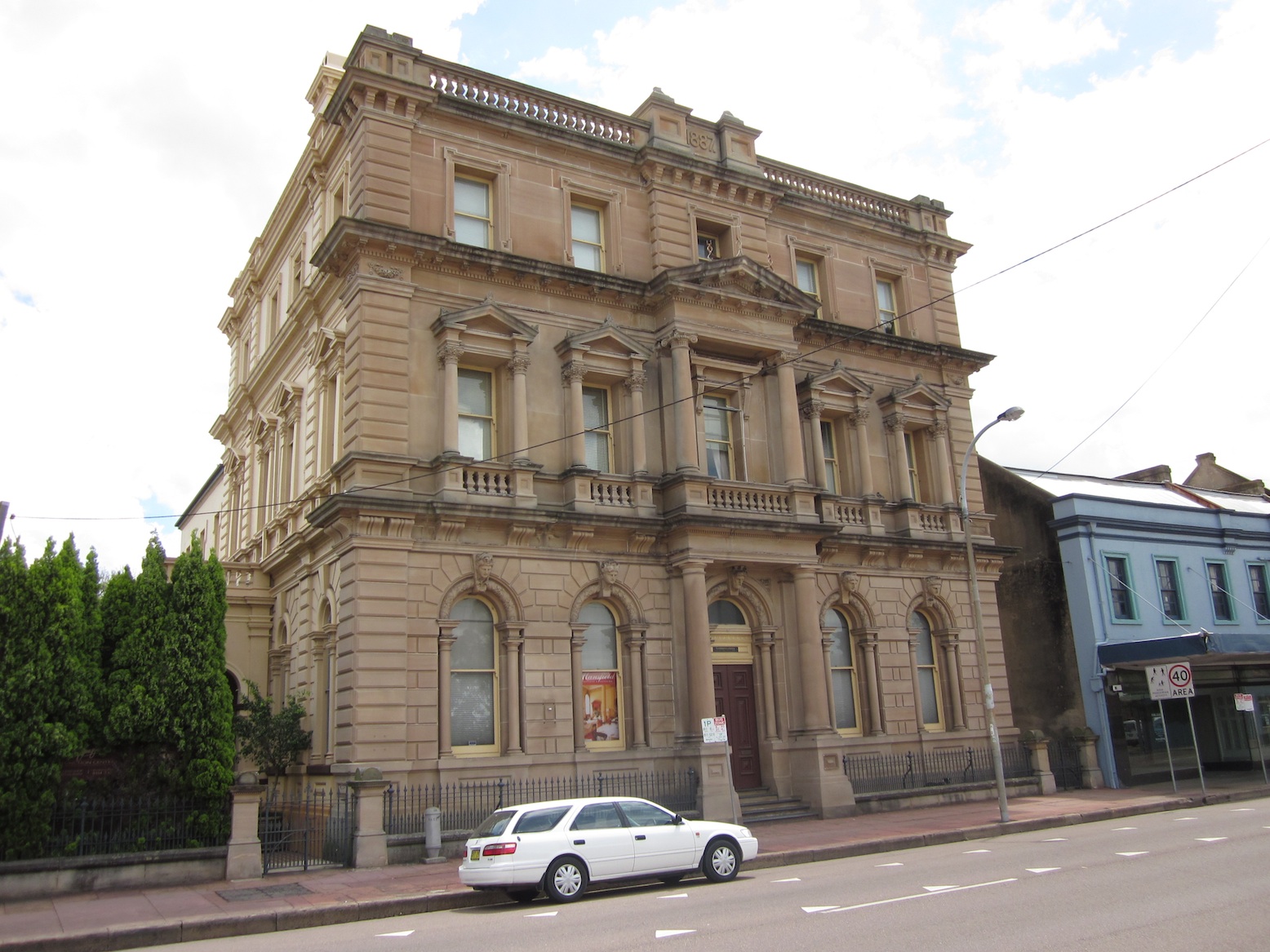 |
| The former Commercial Banking Company of Sydney (later National Australia Bank), built by James Pritchard in 1887 |
 |
| The offices of The Maitland Mercury, situated on High Street, Maitland |
 |
| Walka Water Works, Maitland, NSW |
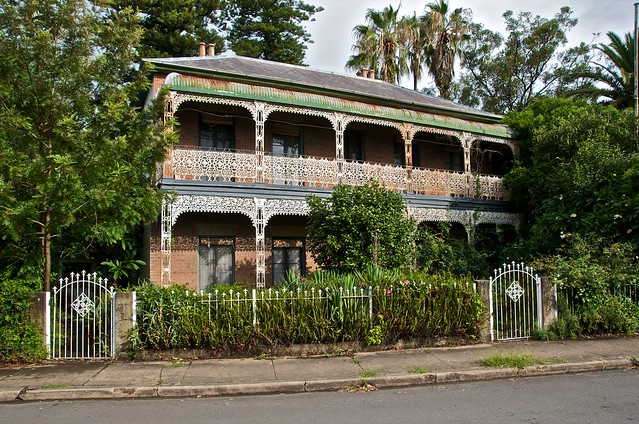 |
| A house at Hannan Street, Maitland, NSW. Nomad Tales |
 |
Grossmann House, Maitland, NSW, Recency style, circa 1870-1. Grossman House is one of two mirror image properties, built side by side on the same lot for business partners, Isaac Beckett and Samuel
Owen
|
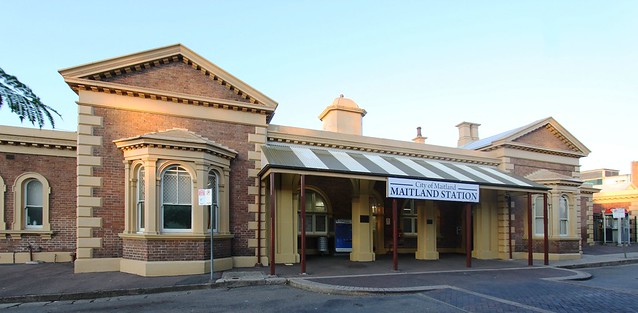 |
| Maitland Railway Station, NSW. built 1850s. OZinOH |
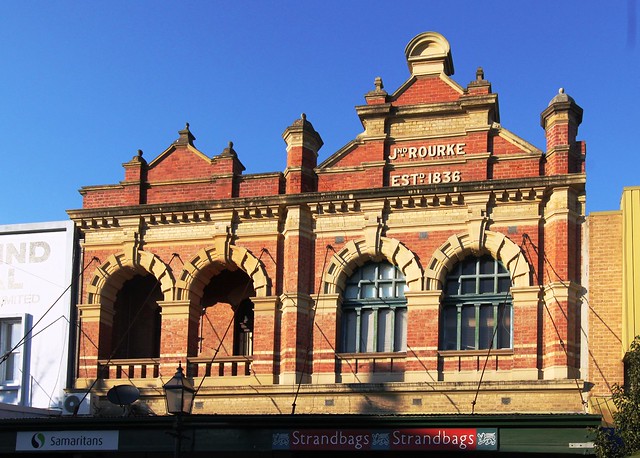 |
| The upper storey of the Jno Rourke building, Maitland, circa 1836. OZinOH |
 |
Hart's Buildings circa 1883 and Hill's Chambers, circa 1907, Maitland, NSW.
|
 |
| The upper floor of a line of shops in Maitland, NSW |
 |
| Johnston's Boot Store, circa 1885, Maitland, NSW |
.jpg) |
| The Maitland Court House, NSW, was built in 1895-96 |
 |
| Barden & Ribee Pty Ltd was a Maitland, NSW, saddlery business, established in 1872 |
.jpg) |
| Maitland's Walka Water Works, Italianate in style, built between 1879 and 1885 |
 |
| Underground Basement: In High Street, under the old Scobies Chambers, an underground basement room has been found, which was used during WWII as a packing area for parcels to be sent to our allies, called ‘Bundles for Britain.” Another underground chamber nearby was used to grow mushrooms. Scobies Chambers, High Street, Maitland, NSW, built 1880 |
 |
| Maitland Train Stations, Hunter Valley Steamfest, NSW |
.jpg/640px-Former_synagogue_in_Maitland_(1).jpg) |
| Former synagogue in Maitland, NSW, built in 1879 by James Pritchard |
.jpg) |
| Maitland Lodge, NSW, of Unity Masonic Hall and Lodge built from 1886 to 1927 |
 |
| St Mary's the Virgin Anglican Church, replaced an earlier 1843 church, opened for services on 18 July 1867, Maitland, NSW |
 |
| St Joseph's Catholic Church in East Maitland, NSW |
 |
| Maitland's Victorian Italianate post office was built in 1881, NSW |
 |
| Former Cohen's warehouse 226 High Street, Maitland, N.S.W |
 |
| Maitland Jewish Cemetery, NSW |
 |
| 256 High Street, corner of Hunter Street (Maitland Mercury building) |
Things To Do and Places To Go
Grossman House
Glebe Cemetery is Maitland's oldest burial ground
greatnorthroad.com.au



























































.jpg)






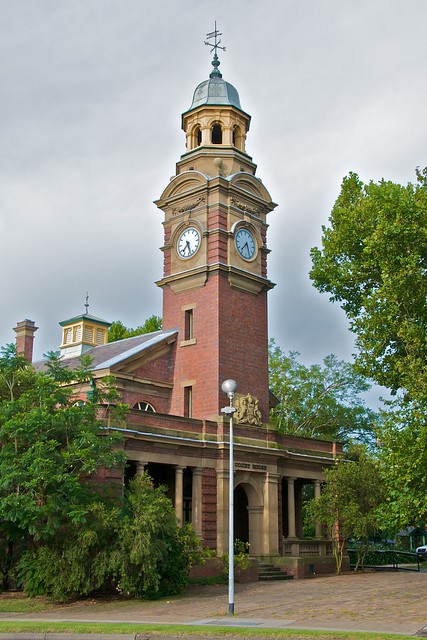
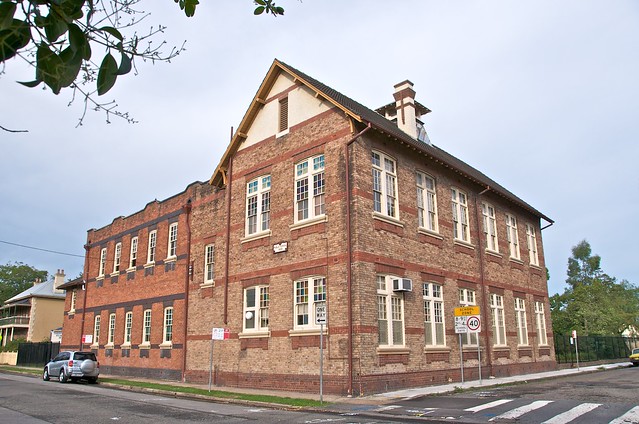


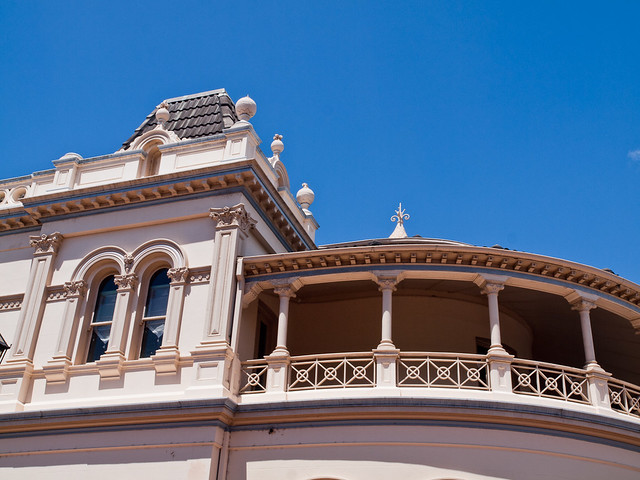




.jpg)

.jpg)


.jpg/640px-Former_synagogue_in_Maitland_(1).jpg)
.jpg)





































